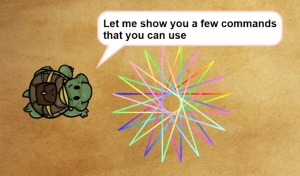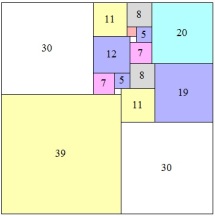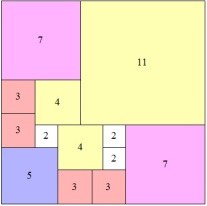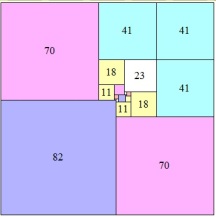Welcome to this week’s Math Munch!
I’ve been really into squares lately. Maybe it’s because I recently ran across a new puzzle involving squares– something called Mrs. Perkin’s quilt.
The original version of the puzzle was published way back in 1907, and it went like this: “For Christmas, Mrs. Potipher Perkins received a very pretty patchwork quilt constructed of 169 square pieces of silk material. The puzzle is to find the smallest number of square portions of which the quilt could be composed and show how they might be joined together. Or, to put it the reverse way, divide the quilt into as few square portions as possible by merely cutting the stitches.”
Said in another way, if you have a 13 by 13 square, how can you divide it up into the smallest number of smaller squares? Don’t worry, you get to solve it yourself– I’m not including a picture of the solution to that version of the puzzle because there are so many beautiful pictures of solutions to the puzzle when you start with larger and smaller squares. Some are definitely more interesting than others. If you want to start simple, try the 4 by 4 version. I particularly like the look of the solution to the 18 by 18 version.
Maybe you’re wondering where I got all these great pictures of Mrs. Perkin’s quits. And– wait a second– is that the solution to the 152 by 152 version? It sure is– and I got it from one of my favorite math websites, the Wolfram Demonstrations Project. The site is full of awesome visualizations of all kinds of things, from math problems to scans of the human brain. The Mrs. Perkin’s quilts demonstration solves the puzzle for up to a 1,098 by 1,098 square!
Next up, we here at Math Munch are big fans of unusual calculators. Marble calculators, domino calculators… what will we turn up next? Well, here for your strange calculator enjoyment is a water calculator! Check out this video to see how it works:
I might not want to rely on this calculator to do my homework, but it certainly is interesting!
 Finally, meet Snap the Turtle! This cute little guy is here to teach you how to make beautiful math art stars using computer programming.
Finally, meet Snap the Turtle! This cute little guy is here to teach you how to make beautiful math art stars using computer programming.
On the website Tynker, Snap can show you how to design a program to make intricate line drawings– and learn something about computer programming at the same time. Tynker’s goal is to teach kids to be programming “literate.” Combine computer programming with a little math and art (and a turtle)– what could be better?
I hope something grabbed your interest this week! Bon appetit!



The binary clock is really neat with the transfers of the water from one level to the next. I am curious how finicky it was to get the tubes to go right.
The video was really cool especially when liquid was being carried from one glass cup to the other. It was amazing it was able to go to another cup without spilling the liquid.
This was great video!
This video was cool and very interesting how the liquids in the cups are being carried to each cup and the liquid didn’t even spilled.I have to say that is really clever.That is something new to me to be used as a calculator.
The water calculator was very puzzling to me. I did not understand how you can use that as a calculator. Also, how can all of the water get in the next cup. My final question is why does each cup have a number on it.
This video is amazing, it was really cool how they got the liquid to move to another cup without it spilling, this is my first time seeing something like and it is really cool.
The video was really cool. I liked how liquid was being carried from one glass cup to the other. I thought the water would get spilled!!!
This was great video!
this video is cool. I like the way the liquid goes from one cup to the other. tis was also confusing to me because I don’t understand the numbers on the cups.
Hi, Emanuel! Thanks for the comment. The numbers on the cups are a little confusing… but did you notice how much water he pours in when the smaller cups tip into the larger cups? The numbers he uses are the numbers in binary, which is a way of writing numbers that uses only 1s and 0s. If you want to learn more, I recommend you look up binary on the internet! There are a lot of great things to learn about binary.
I fond this video very cool. It looked like stairs when all the cups were lined up.
Wow, thats really cool how the siphon works on the liquid binary counter! I see how it is a binary counter but I’m a little confused on how you would use it as a calculator…
This is awesome, when it reaches a certain point it drains its self automatically.I love how its a step by step.
I really liked this video. But the only things that i am confused about is the numbers. Also i liked how the liquid went to a different cup to another.
WOW that’s so cool!!!
This video is cool because the cups are small and then it gets big. but I am still confused about it. it was cool that the liquid went to a different cup.This video id so cool
I really enjoyed the video. I thought it was very cool to see how to water didn’t spill! But I didn’t understand how the number system worked, for example, when water was added, the little notations said “Now the state is 0011.” I didnt get that. Also, when the one cup was giving water to another cup, it said “now the state is 0.” Is it 0 because there was no water in it?
this video is good I don’t get how it stayed in the same cup for a while
Why did the liquid drain only when the water level reached above the siphon?
Great question, Jake! Your question gets at how this is a calculator and how it uses binary. The first cup can only hold 1 cup of water. When you add another cup, they combine and carry over into the second cup– which can hold 2 cups of water. When you add another cup, the first cup can hold it– so you have 3 cups of water total. But when you add another (4!), neither the first or second cups can hold it, so it carries over into the third cup. If this doesn’t quite answer your question, watch the video carefully to see when the water spills over. Thanks for the great question!
It was really cool how the liquid traveled from one cup to another without spilling! i was just confused by the numbers on the cups and when he was counting by tens.
This video was very cool! it was very cool when he carried the liquid in each cup without spilling. At first I was confessed with the numbers on the cups but I re-watched the video and I saw that he poured the number of cups into each one however many times it said.
I like this video because it shows geometry in a very fun halloween sort of way. i love that its creative and i really enjoyed this video.
I think this video is super cool I wonder how they made the water go through the tubes and why the water went down when you pored more water!
This video is cool because you can make stairs with cups and a couple tubes
why is that 160 cubes and i can see a smiley face
this video is cool because for each number the cup gets bigger so it could hold that exact capacity of liqud
The video was really cool especially when liquid was being carried from one glass cup to the other. It was amazing it was able to go to another cup without spilling the liquid.
This was great video!
This was a really cool idea but I’m still wondering how the cups stayed halfway full and then after they were filled all the way, completely empty themselves.
A interesting concept that requires quite a bit of fine tuning because the holes needing to be the perfect size to avoid spillage. However, I noticed that it would actually make more work because you still would need to add the results together after adding the problem.
A interesting concept but I cannot see how it is helpful.